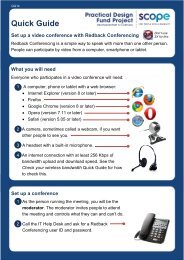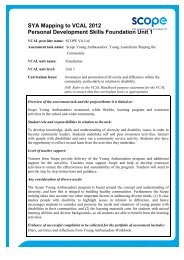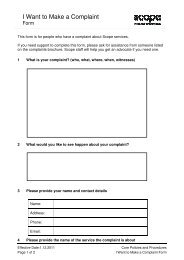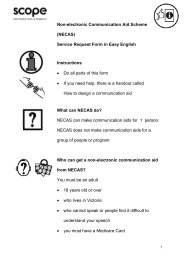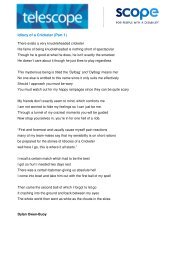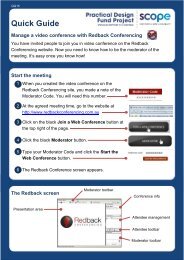Positive behaviour support Getting it right from the start
Positive behaviour support Getting it right from the start
Positive behaviour support Getting it right from the start
Create successful ePaper yourself
Turn your PDF publications into a flip-book with our unique Google optimized e-Paper software.
<strong>Pos<strong>it</strong>ive</strong> <strong>behaviour</strong> <strong>support</strong>: <strong>Getting</strong> <strong>it</strong> <strong>right</strong> <strong>from</strong> <strong>the</strong> <strong>start</strong> - Facil<strong>it</strong>ators reference manual 67<br />
1. Changes to <strong>the</strong> environment<br />
This involves an understanding of relevant environmental factors that may be contributing to<br />
<strong>the</strong> <strong>behaviour</strong> of concern. An analysis of <strong>the</strong> STAR charts will have identified possible factors<br />
which may include undiagnosed medical cond<strong>it</strong>ions or possible side effects to medication. In<br />
add<strong>it</strong>ion we need to plan how we will change <strong>the</strong> environment to ensure a ‘smooth’ f<strong>it</strong> between<br />
<strong>the</strong> individual and where <strong>the</strong>y live and work.<br />
2. Teaching skills<br />
This involves selecting and implementing skill development strategies, that is, skills <strong>the</strong><br />
person can be <strong>support</strong>ed to learn, instead of using <strong>the</strong> <strong>behaviour</strong> of concern. Skill development<br />
strategies need to be linked to <strong>the</strong> reason why <strong>the</strong> person is showing <strong>the</strong> <strong>behaviour</strong> of concern<br />
and <strong>the</strong> skills taught need to be as effective as if <strong>the</strong> person was using <strong>the</strong> <strong>behaviour</strong> of concern.<br />
3. Short-term change strategies<br />
These may be required for a short period of time to produce a rapid change in <strong>behaviour</strong>. These<br />
strategies are used to facil<strong>it</strong>ate a more immediate change to <strong>the</strong> <strong>behaviour</strong><br />
4. Immediate response strategies<br />
These strategies are used to minimise risk to <strong>the</strong> person and o<strong>the</strong>rs by planning responses<br />
aimed at de-escalating or managing a serious episode of <strong>the</strong> <strong>behaviour</strong>. These strategies provide<br />
all involved w<strong>it</strong>h a plan for immediately responding to <strong>the</strong> <strong>behaviour</strong> as <strong>it</strong> occurs. These strategies<br />
do not promote long-term <strong>behaviour</strong> change; <strong>the</strong>y are only intended to manage a serious episode<br />
of <strong>the</strong> <strong>behaviour</strong>.<br />
Putting what you have learnt into practice<br />
Over <strong>the</strong> past two days you have covered topics including<br />
• human <strong>right</strong>s<br />
• <strong>the</strong> importance of background factors and <strong>the</strong>ir potential impact on <strong>the</strong> people<br />
you <strong>support</strong><br />
• <strong>the</strong> importance of getting to know <strong>the</strong> people you <strong>support</strong> well and how this may<br />
affect <strong>the</strong>y way <strong>the</strong>y interact or behave on a daily basis<br />
• stages of communication development<br />
• defin<strong>it</strong>ions of <strong>behaviour</strong>s of concern<br />
• functional <strong>behaviour</strong>al assessment<br />
• <strong>the</strong> recording of STAR charts<br />
• Motivation Assessment Scale<br />
As a team you have focussed on one person you all <strong>support</strong> and identified at least three<br />
<strong>behaviour</strong>s of concern in relation to that person.<br />
On your return to your work <strong>it</strong> is important to practice what has been covered.<br />
It is expected that by <strong>the</strong> beginning of day 3 of this program you will have completed<br />
as a staff team step 1 to 4 of a functional <strong>behaviour</strong> assessment.<br />
Refer to Appendix 2 for details




